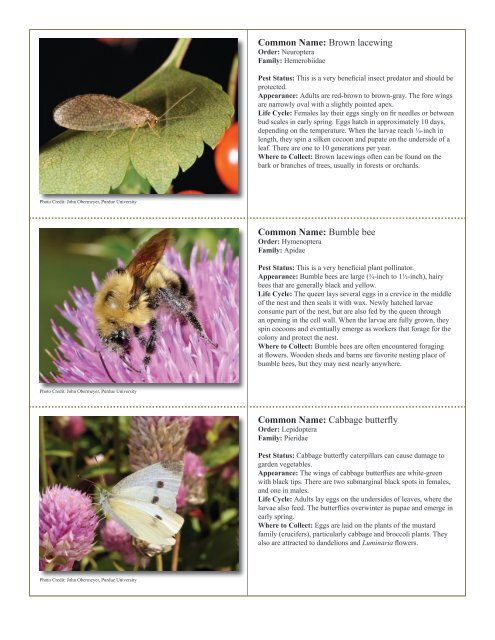to download pdf - Purdue Extension Entomology - Purdue University
to download pdf - Purdue Extension Entomology - Purdue University
to download pdf - Purdue Extension Entomology - Purdue University
Create successful ePaper yourself
Turn your PDF publications into a flip-book with our unique Google optimized e-Paper software.
Common Name: Brown lacewing<br />
Order: Neuroptera<br />
Family: Hemerobiidae<br />
Pest Status: This is a very beneficial insect preda<strong>to</strong>r and should be<br />
protected.<br />
Appearance: Adults are red-brown <strong>to</strong> brown-gray. The fore wings<br />
are narrowly oval with a slightly pointed apex.<br />
Life Cycle: Females lay their eggs singly on fir needles or between<br />
bud scales in early spring. Eggs hatch in approximately 10 days,<br />
depending on the temperature. When the larvae reach ¼-inch in<br />
length, they spin a silken cocoon and pupate on the underside of a<br />
leaf. There are one <strong>to</strong> 10 generations per year.<br />
Where <strong>to</strong> Collect: Brown lacewings often can be found on the<br />
bark or branches of trees, usually in forests or orchards.<br />
Pho<strong>to</strong> Credit: John Obermeyer, <strong>Purdue</strong> <strong>University</strong><br />
Common Name: Bumble bee<br />
Order: Hymenoptera<br />
Family: Apidae<br />
Pest Status: This is a very beneficial plant pollina<strong>to</strong>r.<br />
Appearance: Bumble bees are large (¾-inch <strong>to</strong> 1½-inch), hairy<br />
bees that are generally black and yellow.<br />
Life Cycle: The queen lays several eggs in a crevice in the middle<br />
of the nest and then seals it with wax. Newly hatched larvae<br />
consume part of the nest, but are also fed by the queen through<br />
an opening in the cell wall. When the larvae are fully grown, they<br />
spin cocoons and eventually emerge as workers that forage for the<br />
colony and protect the nest.<br />
Where <strong>to</strong> Collect: Bumble bees are often encountered foraging<br />
at flowers. Wooden sheds and barns are favorite nesting place of<br />
bumble bees, but they may nest nearly anywhere.<br />
Pho<strong>to</strong> Credit: John Obermeyer, <strong>Purdue</strong> <strong>University</strong><br />
Common Name: Cabbage butterfly<br />
Order: Lepidoptera<br />
Family: Pieridae<br />
Pest Status: Cabbage butterfly caterpillars can cause damage <strong>to</strong><br />
garden vegetables.<br />
Appearance: The wings of cabbage butterflies are white-green<br />
with black tips. There are two submarginal black spots in females,<br />
and one in males.<br />
Life Cycle: Adults lay eggs on the undersides of leaves, where the<br />
larvae also feed. The butterflies overwinter as pupae and emerge in<br />
early spring.<br />
Where <strong>to</strong> Collect: Eggs are laid on the plants of the mustard<br />
family (crucifers), particularly cabbage and broccoli plants. They<br />
also are attracted <strong>to</strong> dandelions and Luminaria flowers.<br />
Pho<strong>to</strong> Credit: John Obermeyer, <strong>Purdue</strong> <strong>University</strong>
















